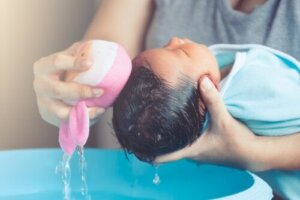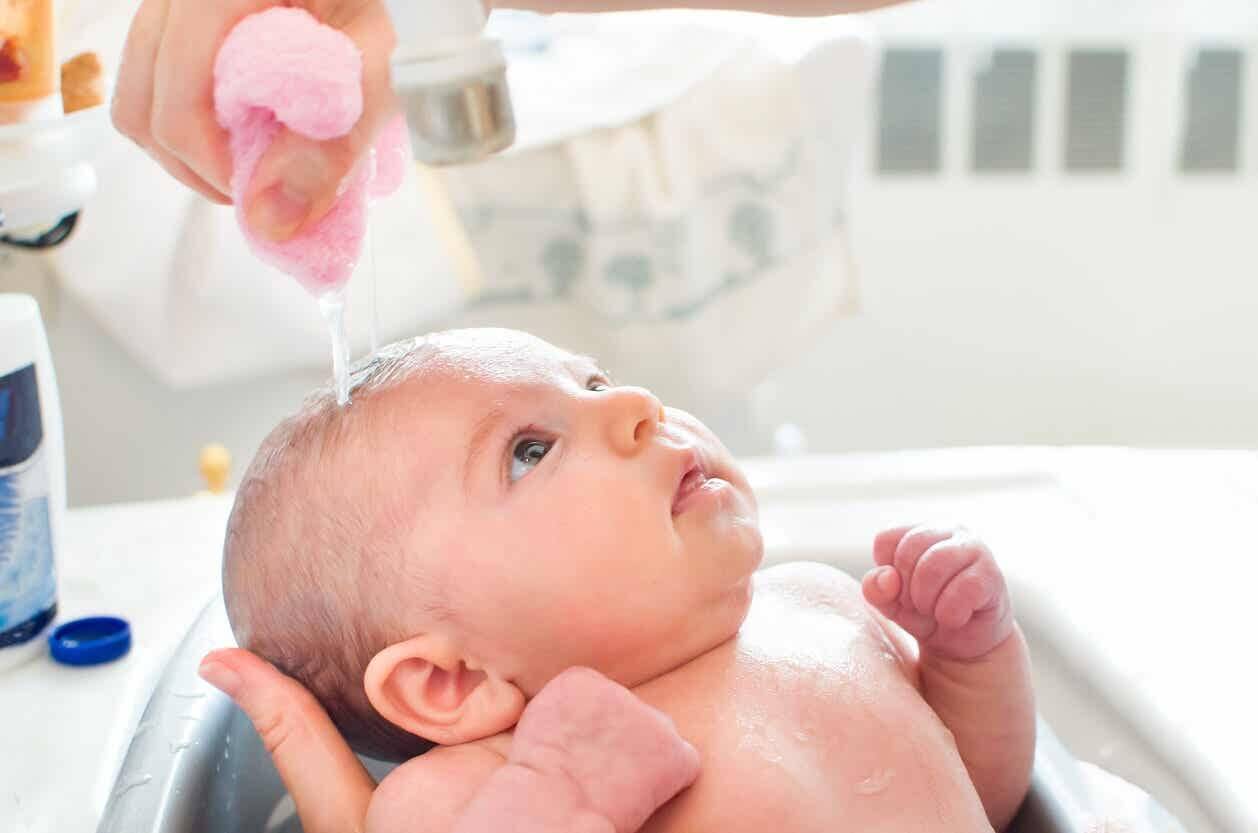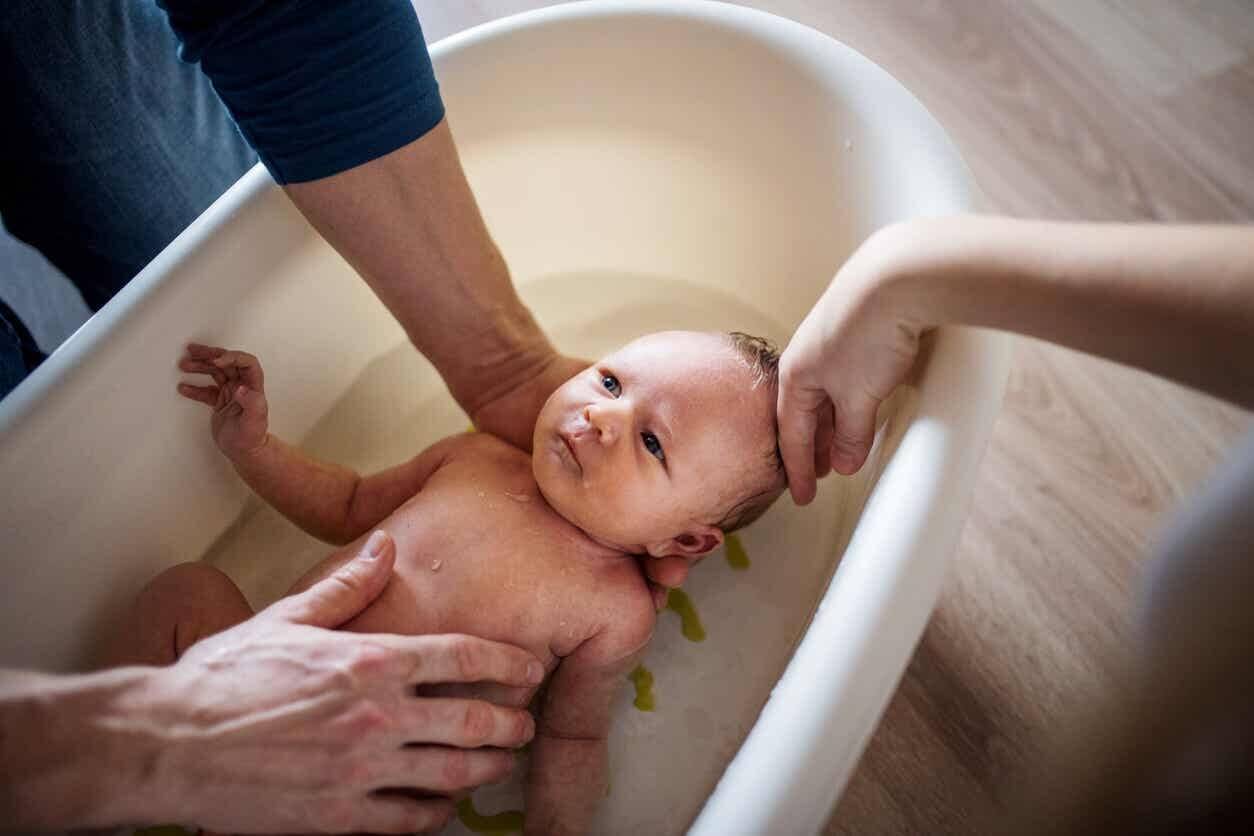How to Wash Your Baby's Hair and How Often


Written and verified by the dermatologist Maria del Carmen Hernandez
Washing and rinsing the baby’s hair for the first time is one of the most awaited and pleasant moments for parents. The baby’s skin is more delicate due to its incomplete development. In addition, it doesn’t yet possess the property of retaining moisture.
Characteristics of baby hair
The hair of a newborn baby isn’t the definitive hair it’ll have in the future. Rather, it’s a type of hair that they’ll shed later on. After a while, new hair will grow, which will be similar to the hair they’ll have in the first years of life.
In addition, the color of babies’ hair won’t be the definitive color because, at birth, the melanocytes, which are responsible for coloring the hair, aren’t yet mature.

When should I wash my baby’s hair?
The World Health Organization (WHO) recommends postponing the baby’s first bath until 24 hours after birth, or if this isn’t possible, wait at least 6 hours.
Choosing the right products for your baby’s first bath
Choose the shampoo according to your baby’s age. In addition, it shouldn’t be irritating and should have a neutral or alkaline pH. Products for babies or children have special formula so as not to irritate their eyes, not to irritate their hair, and to be hypoallergenic.
Try to use products with mild fragrances because strong perfumes can cause irritation in children. After 6 months of age, you can start using conditioners if needed.
You may be interested in: 6 tips for your newborn baby’s first bath
How often should I wash my baby’s hair?
Newborn babies don’t need a bath every day. In fact, only two hair rinses per week are necessary because they rarely sweat or get dirty enough to require it on a daily basis.
At the same time, frequent washing of babies’ hair can cause dryness and discomfort, which can make bath time unpleasant for the infant.
Baths shouldn’t last more than 10 minutes. Prolonged periods in the water can alter the protective barrier function of the skin.
If your baby doesn’t have much hair, wash their hair in a gentle manner in order to remove excess oil or cradle cap flakes.
Cradle cap
Cradle cap, also called infantile seborrheic dermatitis, is a non-inflammatory scaly manifestation of the skin that occurs between 3 weeks and 4 months of age. In most cases, it’s self-limiting and goes away on its own with time.
The clinical manifestations observed on the skin are the following:
- Erythematous plaques
- Yellowish scales of greasy appearance
- Asymptomatic, without pain or pruritus
Even if infantile seborrheic dermatitis is a condition that resolves spontaneously, there are several treatments that can accelerate the process.
Wash your baby’s hair with a mild baby shampoo along with an emollient (baby oil or petroleum jelly) prior to shampooing. As a result, the oil will help soften the scales and make them easier to remove.
Read also: How often should babies be bathed?
How to wash my baby’s hair?
Baby hair is very delicate and fine. Therefore, all movements or manipulations should be gentle. The bathtub should be filled, always using lukewarm water that doesn’t exceed 95 ºF–it shouldn’t be hot or cold. If you don’t have a thermometer to measure the temperature, you can use your wrist or elbow to test it.

Ideally, the body should be rinsed first and the hair should be rinsed last to prevent the baby from getting cold. Apply the shampoo and make gentle movements. At the same time, using your hand or a cup, rinse the product backward to prevent it from dripping down the face.
When drying, don’t rub vigorously, but rather gently, as if caressing the hair. In addition, babies tend to lose heat through their heads. So, it’s best is to minimize the time they spend with a wet scalp.
About washing your baby’s hair
Bathing the baby is a time that strengthens the bond with the parents. It usually produces uncertainty or questions about when and how to do it, and there are different opinions on the matter.
Ideally, you should wait until the umbilical cord falls off before bathing your baby for the first time. From then on, it’s not advisable to do it every day. Finally, its duration should be short so as not to alter the lipid layer of the skin.
Washing and rinsing the baby’s hair for the first time is one of the most awaited and pleasant moments for parents. The baby’s skin is more delicate due to its incomplete development. In addition, it doesn’t yet possess the property of retaining moisture.
Characteristics of baby hair
The hair of a newborn baby isn’t the definitive hair it’ll have in the future. Rather, it’s a type of hair that they’ll shed later on. After a while, new hair will grow, which will be similar to the hair they’ll have in the first years of life.
In addition, the color of babies’ hair won’t be the definitive color because, at birth, the melanocytes, which are responsible for coloring the hair, aren’t yet mature.

When should I wash my baby’s hair?
The World Health Organization (WHO) recommends postponing the baby’s first bath until 24 hours after birth, or if this isn’t possible, wait at least 6 hours.
Choosing the right products for your baby’s first bath
Choose the shampoo according to your baby’s age. In addition, it shouldn’t be irritating and should have a neutral or alkaline pH. Products for babies or children have special formula so as not to irritate their eyes, not to irritate their hair, and to be hypoallergenic.
Try to use products with mild fragrances because strong perfumes can cause irritation in children. After 6 months of age, you can start using conditioners if needed.
You may be interested in: 6 tips for your newborn baby’s first bath
How often should I wash my baby’s hair?
Newborn babies don’t need a bath every day. In fact, only two hair rinses per week are necessary because they rarely sweat or get dirty enough to require it on a daily basis.
At the same time, frequent washing of babies’ hair can cause dryness and discomfort, which can make bath time unpleasant for the infant.
Baths shouldn’t last more than 10 minutes. Prolonged periods in the water can alter the protective barrier function of the skin.
If your baby doesn’t have much hair, wash their hair in a gentle manner in order to remove excess oil or cradle cap flakes.
Cradle cap
Cradle cap, also called infantile seborrheic dermatitis, is a non-inflammatory scaly manifestation of the skin that occurs between 3 weeks and 4 months of age. In most cases, it’s self-limiting and goes away on its own with time.
The clinical manifestations observed on the skin are the following:
- Erythematous plaques
- Yellowish scales of greasy appearance
- Asymptomatic, without pain or pruritus
Even if infantile seborrheic dermatitis is a condition that resolves spontaneously, there are several treatments that can accelerate the process.
Wash your baby’s hair with a mild baby shampoo along with an emollient (baby oil or petroleum jelly) prior to shampooing. As a result, the oil will help soften the scales and make them easier to remove.
Read also: How often should babies be bathed?
How to wash my baby’s hair?
Baby hair is very delicate and fine. Therefore, all movements or manipulations should be gentle. The bathtub should be filled, always using lukewarm water that doesn’t exceed 95 ºF–it shouldn’t be hot or cold. If you don’t have a thermometer to measure the temperature, you can use your wrist or elbow to test it.

Ideally, the body should be rinsed first and the hair should be rinsed last to prevent the baby from getting cold. Apply the shampoo and make gentle movements. At the same time, using your hand or a cup, rinse the product backward to prevent it from dripping down the face.
When drying, don’t rub vigorously, but rather gently, as if caressing the hair. In addition, babies tend to lose heat through their heads. So, it’s best is to minimize the time they spend with a wet scalp.
About washing your baby’s hair
Bathing the baby is a time that strengthens the bond with the parents. It usually produces uncertainty or questions about when and how to do it, and there are different opinions on the matter.
Ideally, you should wait until the umbilical cord falls off before bathing your baby for the first time. From then on, it’s not advisable to do it every day. Finally, its duration should be short so as not to alter the lipid layer of the skin.
All cited sources were thoroughly reviewed by our team to ensure their quality, reliability, currency, and validity. The bibliography of this article was considered reliable and of academic or scientific accuracy.
- Elish D, Silverberg NB. Infantile seborrheic dermatitis. Cutis. 2006 May;77(5):297-300. PMID: 16776285.
- Janniger CK, Bryngil JM. Hair in infancy and childhood. Cutis. 1993 May;51(5):336-8. PMID: 8513685.
- Neri I, Piccolo V, Cocchi G, Starace M, Patrizi A, Dika E, Piraccini BM. Hair in newborns and infants: clinical and dermoscopic evaluation of 45 cases. Br J Dermatol. 2013 Oct;169(4):896-900. doi: 10.1111/bjd.12459. PMID: 23746094.
This text is provided for informational purposes only and does not replace consultation with a professional. If in doubt, consult your specialist.








